West Beacon Farm wind turbines,
Leicester Friends of the Earth statement
Public enquiry held at
North West Leicestershire District Council,
Coalville, 21 July 1992
Summary
Leicester Friends of the Earth consider the wind turbines at West Beacon Farm to be a positive and encouraging development in the move towards clean alternative forms of electricity generation. The Charnwood forest area has a history of utilizing wind power dating back hundreds of years. These wind power generators can only help ease the pressures on our environment, and Leicester Friends of the Earth therefore urge the Inspector of the public enquiry to consider the turbines favourably.
1. General Background
1.1 Renewable Benefits
Compared with energy technologies currently in use, those that harness the sun, the wind and other natural energy flows, are relatively benign. Together, they provide a diverse, secure and inexhaustible source of energy. The very diversity of sources, the small size of many of the technologies and the short time it takes to build them, offers greater flexibility in planning – especially in the electricity supply sector, where conventional power plant can take ten years or more to plan and construct.
Small units, generating electricity locally, also reduce fuel transport costs and transmission losses, can strengthen the electricity grid and can improve the reliability of supply by reducing dependence on fossil fuels.
Most importantly, coupled with a programme of improved energy efficiency, renewable energy can begin to displace fossil fuels and nuclear power and thus help reduce the risks to the environment from acid rain, the accumulation of nuclear waste, the threat of nuclear accidents, nuclear weapons proliferation and climate change.
A study by Friends of the Earth outlined a strategy of investment and conservation which conservatively concluded that a 20% contribution of primary energy from renewables was feasible in the UK by the year 2025, assuming a 30% reduction in primary energy demand achieved through energy efficiency and conservation (Figure 1).
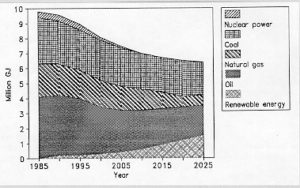
1.2 Environmental Impact and the Public
Renewable energy is popular: according to a Gallup opinion poll for Friends of the Earth [2], people give renewable energy a far higher rating than ‘dirty’ fossil fuels or ‘unsafe’ nuclear power. 87 per cent of the public think that the Government should do more to develop renewable energy and more than three quarters of the public are prepared to pay extra for it.
All energy systems have an effect on the natural environment. It is inevitable, therefore, that conflicts of interest will arise between providing energy services and ensuring that people, wildlife and open spaces are adequately protected. The environmental impact associated with most renewable energy technologies is considerably less than with the current energy systems that they displace. Nevertheless, there is a range of environmental impacts associated with renewable energy which do have to be addressed and which mean, in some cases, that proposed projects may be inappropriate or unacceptable.
Obtaining planning permission is a major factor in determining the rate at which renewable energy systems are introduced. Problems can be exacerbated where developers have failed to inform, let alone consult, the local community on their activities and intentions, behaviour guaranteed to lead to misunderstandings and hostility.
Whilst it is not possible to hide away renewable energy systems completely, nor make them entirely innocuous, their impact can be considerably reduced by careful design and siting and by modifying their operating regime. Local concerns may be addressed by involving residents in the early stages of the planning process and by ensuring that genuine anxieties are properly considered and acted upon.
It is important when discussing environmental effects to keep the discussion in perspective and be aware of the costs and possible environmental consequences of not deploying renewables.
1.2.1 Example: Wind Energy and Visual Intrusion
Wind turbines can be visually intrusive. They can also look attractive and blend into the landscape. Much depends on the design, size and location of the machines and on the attitudes and preconceptions of the observer.
Beauty, of course, is very much in the eye of the beholder and not everybody in the UK sees wind energy as benign and an important defence against acid rain and climate change. Though few organisations oppose renewable energy per se, faced with the prospect of a wind farm on their doorstep, some countryside and amenity groups feel that they have no choice but to object, even when the proposed wind farms are actually outside (but visible from) protected areas.
Trying to assess the precise impact of visual intrusion is difficult. Some factors such as numbers and scale effects are easily identifiable: small clusters of wind turbines are undoubtedly less visually intrusive than large wind farms. Other factors are problematic: first, how do modern wind turbines compare with more familiar country objects such as farm buildings and silos, power station cooling towers, electricity pylons and cable runs? People have a natural tendency to reject the new and the unfamiliar, and yet to be apparently unconcerned by what might otherwise be seen as entirely unacceptable: the UK countryside is crisscrossed by 10,000 route miles of high voltage overhead cable on more than 50,000 large pylons and there are a quarter of a million route miles of overhead low voltage cables supported on millions of wooden poles.
A public attitude survey conducted on behalf of the Department of Energy showed that those who already have some experience of wind turbines in the locality are overwhelmingly convinced that the countryside is a suitable place for wind turbines and that “they are an efficient use of rural land” [3].
Second, how much weight should be given to visual intrusion as compared to say the acid rain and other chemical pollution avoided by not burning fossil fuels? Sweden, Germany, Poland and other East European countries have practical experience of the damage to forests and lakes caused by emissions from burning coal and oil. Each unit of electricity generated from wind turbines displaces 5-8 grams of sulphur dioxide, 3-6 grams of nitrogen oxides, 750-1250 grams of carbon dioxide, and 40-70 grams of slag and ash. Some states in Germany actually pay a direct environmental credit of around 2.5 pence per unit in recognition of this benefit.
2. History
“Tear it down! Tear it down!” yelled the black-robed abbot. Eight hundred years later, the prelate’s fury still ignites the most volatile account of a contested windmill franchise. The scene of the dispute was the powerful Suffolk monastery, Bury St. Edmunds, but the issue concerned people everywhere [4].
Although the dispute quoted here was mainly about milling rights, some parallels can be drawn to the case being debated at this enquiry. Most importantly, it shows that the utilization of wind power is nothing new. Britain has an enormous wind power potential, which people started to utilize centuries ago. 23 windmills are proved to have existed before the year 1200, at least two of those in Leicestershire [5]. The existence of 260 windmills in Leicestershire is recorded [6] and, despite a decline due to the advent of the steam engine, it is believed that in the middle of the 19th century over 150 windmills were still working in Leicestershire [7]. Two of these were in close proximity to the disputed West Beacon Farm turbines, Finny Hill windmill near Shepshed (Plate 1) and the now derelict windmill in Woodhouse Eaves (Plate 2). These graceful structures were never conceived as visual intrusion or blots in the landscape – on the contrary: After it was badly damaged in a gale in 1895, the Woodhouse Eaves windmill was restored as a landmark (and finally lost to a fire in 1945).
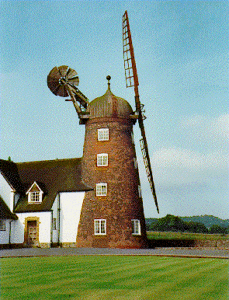
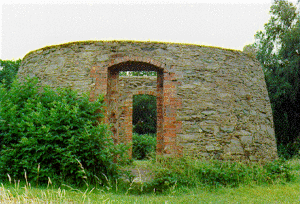
Far from being hostile, the local people got quite attached to ‘their’ windmill. This attitude can still be felt in Woodhouse Eaves, with a model windmill in a garage forecourt (Plate 3) and a street named after the windmill (Plate 4).
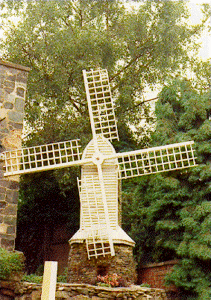
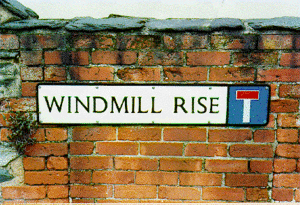
Wind powered water pumps used to be a common feature of the local landscape for decades (Plate 5).
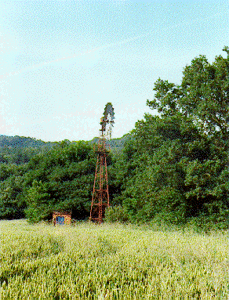
3. North West Leicestershire District Council’s arguments
In the following, the arguments brought forward by North West Leicestershire District Council (NWLDC) against the two wind turbines at West Beacon Farm [8] will be investigated, and counter arguments will be brought forward by Leicester Friends of the Earth (LFoE).
NWLDC: “In December 1983 Mr. Marmont applied to Charnwood Borough Council for permission to erect a large wind turbine close to the border with this Authority’s area. Planning permission was refused by Charnwood Borough Council and Mr. Marmont lodged an appeal with the Secretary of State for the Environment. After hearing the evidence and arguments in support of this large turbine (about 80 feet in height plus blade), the Secretary of State for the Environment dismissed the appeal and refused to grant planning permission, agreeing with his Inspector that the ‘proposal would have a high profile and be an eye catching feature quite out of keeping with the rural character of the area'”.
LFoE: As explained in section 2, Leicestershire, including the Charnwood area, has an extremely long history of wind power utilization. Structures which harness the wind have never before been considered to be out of keeping with the rural character of the area.
NWLDC: ” … the Charnwood Forest area is designated as ‘an area of particularly attractive countryside’ in the statutory County Structure Plan and is therefore afforded special protection. There is a general presumption against any development in the Charnwood Forest area unless it is absolutely essential”.
LFoE: Circumstances have changed since Mr. Marmont’s previous appeal. The Government has now issued draft planning policy guidelines on renewable energy [9]. Section 9 states that “The Government’s policy is to stimulate the exploitation and development of renewable energy sources wherever they have prospects of being economically attractive and environmentally acceptable”. This can and should include rural areas, as section 27 and 23 explain: “The Government continues to recognise the fundamental importance of policies to protect the landscape and wildlife and certain areas are designated in which stronger planning controls apply. It also considers that the economic, social and local environmental benefits conferred on the community from projects for developing renewable energy may be so desirable that local planning authorities should give serious consideration to realising them, even in designated areas.
Local planning authorities should weigh the environmental impact of relevant projects and the benefits which they bring.”
“Development plan policies should recognise that local, regional and national requirements for energy cannot be ignored. …. Planning authorities should also bear in mind that investment in renewable energy development can make an important contribution to the national economy, and can help to lessen the potential impact of global warming”.
It could therefore be argued that the West Beacon Farm turbines are absolutely essential as a pioneering project for harnessing non-polluting energy resources. One should also not forget the great educational value of this development. LFoE understand that several hundred school children have already visited West Beacon Farm. This is a very important aspect at times when schools get inundated with propaganda material from the nuclear industry.
NWLDC then explained that Mr. Marmont, despite the Secretary of State’s decision, erected two smaller turbines in 1986, and replaced those with two larger turbines within NWLDC area. In his explanation Mr. Marmont commented that if he had applied for planning permission it would probably be refused. NWLDC continued: “If no action is taken in this case then other similar structures may be erected in the Charnwood Forest which would have a significant effect on this area of particularly attractive countryside”.
LFoE, whilst far from endorsing Mr. Marmont’s obvious breach of planning control, would contend that planning circumstances with regard to renewable energy have indeed changed, as explained above, and the likelihood of obtaining planning permission would be much greater under similar circumstances today. Also, the argument of setting a precedent is not valid, as has been shown in an enquiry into a much larger wind farm development in Wales. The Inspector reported [10]: “Any fears that this case will create a precedent I consider to be unfounded. The application of the general principle that each case is considered on its merits can ensure that all wind farm proposals are sited with proper regard to interests of landscape conservation”.
NWLDC: “On the wider issue of energy, and the effect of fossil fuels, it is not just a question of developing effective sources of renewable energy, but also more immediately seeking to secure an overall \fBreduction\fR in the amount of energy consumed”.
LFoE, fully agree. However, it is not a question of either renewable energy or energy efficiency. Both aspects need to be addressed immediately, if we are serious about developing a sustainable supply of energy (see Figure 1 above).
NWLDC: “Unfortunately, if industrial structures such as these wind turbines were to remain, it would be difficult for the Local Planning Authorities to resist other large structures in this attractive landscape”.
LFoE would contend that the definition of the term ‘industrial structure’ perhaps needs modification. How can it be justified that the West Beacon Farm turbines, which form Beacon Hill are only visible to the very determined observer (Plate 6), are termed industrial structures, whereas nobody disputes, for example, the Copt Oak transmitter masts (Plate 7), or the massive silos at Rushey Fields farm (Plate 8)? It could be argued that wind turbines are merely an extension of farming activities. Not surprisingly, larger clusters of turbines have been termed wind farms!
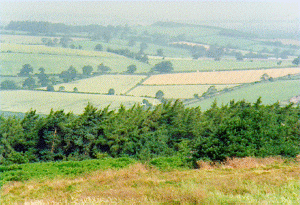
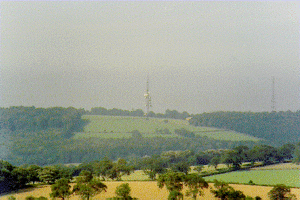
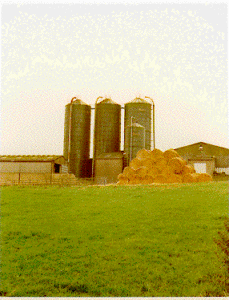
4. Conclusions
It is perhaps not inappropriate to quote the conclusions from the aforementioned Welsh enquiry [10].
“It is evident that, by its very nature, a wind farm usually has to be located in areas where, normally, new development is strictly controlled. However, this scheme has few of the characteristics of ‘normal’ development. The need to conserve the countryside for its own sake and to protect areas of fine landscape is acknowledged. It is necessary to balance such considerations against the positive advantages associated with the exploitation of wind energy. In this particular case I have concluded that while the proposed turbines would intrude into the local scene, … their presence and operation would not materially damage the many fine views and attractive landscapes in the wider area … I consider that the immediate impact of the wind turbine generators would be acceptable. They would become objects of interest in their own right, …, and the main features of the site – the panoramic views and sense of isolation – will remain unaltered.
It is my opinion that these wind turbines, given the positive public response both to this scheme and to the concept of renewable energy, will quickly become an accepted part of this landscape. Any adverse impacts in terms of landscape and visual amenities I consider will, on balance, be outweighed by the many environmental and energy benefits associated with this scheme …”
Leicester Friends of the Earth have nothing further to add, except that the scale and visual intrusion of the West Beacon Farm turbines are orders of magnitude smaller than the Welsh development, which has been given planning permission. We therefore urge the Inspector of the public enquiry to consider the turbines favourably.
Acknowledgements
Some of the information in this briefing is based on the following FoE publication: Flood, M., 1991, Energy without end, Friends of the Earth, London, 75pp.
References and Notes
1. Boyle, S., 1988, An alternative energy path for the UK, Friends of the Earth, London
2. Published on 2 September 1991, this opinion poll, undertaken by Social Surveys (Gallup Poll) Ltd. on behalf of Friends of the Earth, questioned a representative sample of 1010 people. 87% said they wanted the Government to do more to increase the proportion of electricity coming from renewable energy. 77% said they were prepared to pay “slightly more” to see a greater proportion of electricity from renewable energy sources. Only 9% said they would prefer not to pay extra. The amount extra was not specified.
3. Lee, T., Wren, B. & Hickman, M., 1989, Public responses to the siting and operation of wind turbines, Robens Institute and Department of Psychology, University of Surrey
4. Kealey, E.J., 1987, Harvesting the air, windmill pioneers in twelfth-century England, The Boydell Press, Woodbridge, Suffolk
5. Holt, R., 1988, The mills of medieval England
6. Moon, N., 1981, The windmills of Leicestershire and Rutland, Sycamore Press, Melton Mowbray, Leicestershire, 214pp.
7. Loughborough Echo, 3rd August 1990, A majestic reminder of an age gone by, Newspaper article
8. North West Leicestershire District Council, Letter to Leicester Friends of the Earth member Mark Allen, 5th Novenmber 1991, private communication
9. Department of the Environment, Draft planning policy guidance note on renewable energy, 5th December 1991
10. Welsh Office, Decision about proposed development of 24 wind generators at Myndd y Cemmaes, Powys, 19th September 1991
Written by Herbert Eppel, July 1992
